
Will
-
Posts
461 -
Joined
-
Last visited
Content Type
Profiles
Forums
Store
Help Articles
Posts posted by Will
-
-
I got a set for my folks' house, and I think it's great for the price.
-
As an illustration of why this is important, I live in the Research Triangle area in North Carolina, and we have a lot of great coffee shops, and they usually have a halfway decent selection of loose-leaf teas. However, it's near-universal to serve the tea in French press pots. This is annoying, because while the apparatus does keep the leaves in the pot, it causes the tea to (1) oversteep and (2) it prevents a good second steeping.
I also don't love the "French press for tea brewing" thing, but one suggestion I saw recently that was really good is to put the leaf on *top* of the press portion. That serves two functions -- 1, makes it easier to take the leaf out of contact with the water, and 2, prevents the user from actually pressing on the tea leaves.
-
I hate tea bags. I can taste them. I also hate the empty bags you perch on a stirrer that tea shops use to brew one cup of whatever, once again, I can taste them.
Yeah, I think loose leaf is basically a given in a case like this. And definitely offer loose tea and good teaware for sale in addition to serving it at the shop.
-
I think tea service in a setting like that is just tricky to do right. Tea has a lot of variables (and a lot of personal preference) in terms of how it can be made.
I would start with figuring out your approach to water. Good water is very important to tea -- that includes the water itself, as well as how it's heated. A good spring water with not too high TDS would be ideal, but I understand that's not practical in most shop settings, so I'd say an industrial strength carbon filter system (not RO) would be ideal. If you can use some Zojirushi water boilers and some smaller electric kettles, this will probably give better results than most industrial strength boilers like a Bunn or something.
Education is the other thing - there are a lot of people with good experience in preparing coffee, but with tea, you'll need to educate your staff on a continuing basis. While I'm not a fan of the "scientific" approach to tea making in my own tea brewing, I think it's important for consistency in this kind of setting.
That is, X grams of tea (using weight is far preferable for tea than volume), water at X temperature, steep for X amount of time (or, alternatively, for this last parameter, give the customer a recommendation of when to pour, but give them the ability to choose when to pour the tea, so that they can control the strength).
With the teaware, I'd say try not to get super fussy, but I would suggest white porcelain for the drinking vessel, and either porcelain or glass for the brewing vessel.
If you don't have a lot of experience choosing tea, I'd get some help in terms of finding suppliers and choosing the actual teas.
-
Yeah, Paul Qui's current truck is called East Side Kings; there are a few different locations. I went recently, and the food was excellent (price is not the cheapest and portions are small, but certainly falls within the constraints mentioned above). Lots of great food trucks around, and most of them are clustered in little semi-permanent "trailer parks". I think most of the food I had from the trucks there was good to excellent, and I like the way the city has really helped to encourage, rather than stifle the whole food truck thing. I live in LA where the whole upscale food truck thing seemed to start taking off, but really, most of the trucks here aren't very good, and the city really doesn't do a lot to make it easier for them to operate. In contrast, Austin has really done a great job of creating an ecosystem where the barrier to entry isn't bad, and there's enough competition that the quality of the food seems to be fairly good.
If you've got the money, would really also suggest Uchiko / Uchi, the restaurant run by his former mentor. But definitely far above the price range you're talking about.
-
This thread has almost 60,000 views. No one has figure out the way to make good pulled noodles. :-)
I think the way has been alluded to several times -- a lot of practice / know-how.
The specific composition of the dough isn't as important as that. The reason more people can't do it (myself included) is because they haven't spent the time to master the skill, which is not easy.
And to be honest, most people don't need to know how to make these at home. Personally, I usually just go out if I'm craving handmade noodles, but more rustic hand-cut ones are fine in a pinch too.
-
Overall, 00 flour isn't especially high-gluten, is it?
-
So, looking at the description again, this is a riff on a dish from a contemporary restaurant on the outskirts of Taipei; the dish is definitely "fusion". The original dish it's based on was fresh tofu with uni (sea urchin) on top, soy sauce, a hint of wasabi, and a wedge of avocado. Whatever the origin, the dish is pretty tasty.
She has the more usual variant with soy sauce, green onion, sesame oil (and optional pidan) on the previous page (41).
-
The portable butane ones that run of canisters work pretty well, and can be bought fairly cheaply at Asian supermarkets. But I think some of the ~ $70 induction burners are also supposed to be decent, assuming your cookware's induction capable.
-
How'd you like the drink?
Not mind-blowing to me - the whisky taste didn't really come through that strongly, and the bitter-sweet / spice flavors of the Gran Classico and vermouth were a bit strong. I'm not the biggest Negroni fan to start with, though, so maybe I'm not the best person to comment. I did enjoy this more than a standard Negroni, because the bitterness was a little more balanced.
-
That Harajuku sounds delicious. Anyone happen to know the ratios? Not that I have/can afford Hukushu, mind...
I was seated at a table, so I didn't watch it being made, but guessing you could make it as you'd make a Negroni, so 1:1:1 might not be a bad starting point.
I'm guessing that's a nerdy enough question that one of the bartenders might answer if you give them a call.
Here's an article with a bit more about the drinks there.
I'm a bit skeptical about the suggestion that "Tokyo cocktail style" would be more of a fresh program - most of the cocktail bars I know about in Tokyo are much more focused on classics and solid execution than fresh / seasonal ingredients.
-
Foil-lined wok , with the food on top of chopsticks going across the top, works pretty well for me.
-
btw, a restaurant here in LA has an entire section of negroni variations on their cocktail menu.
http://hinokiandthebird.com/wine-list/
Classic Negroni
Gin, sweet vermouth & Campari, rocks, orange twist
White Negroni
Amère sauvage (bitter gentian), bianco vermouth, rocks, grapefruit twist
Harajuku
Hakushu Single Malt Whiskey, Gran Classico, Maurin Quina & Chocolate bitters
Kingston Negroni
Smith + Cross Jamaican Rum, Gran Classico, sweet vermouth, rocks, orange twist
I tried the Harajuku recently; I wasn't blown away, but it was definitely interesting and had potential.
-
 1
1
-
-
I would just suggest trying to focus less on being super weird and extreme, and more on just making good food. Having food that tastes good is the best "wow" factor to convert skeptics, IMHO.
Yes and no. Yes, the food has to taste good, but your friendly neighborhood vegetable curry won't cut it for the feel of these meals. The standard for these feasts is five to six courses (including cheese and sorbet interludes). The things mentioned in the original post are not meant to be all implemented (or indeed any of them), it's just what was in my head when I wrote the post. But I have to find some idea to develop the menu around.
I think there is a wide area between "your friendly neighborhood vegetable curry" and "Pressure-cooked mustard seeds" as "caviar" (though I think there are fine-dining places which manage to make SE Asian style curries that are both beautiful and refined tasting). My point is just that you don't have to use molecular gastronomy techniques to make nice looking and good tasting vegetarian or vegan food. Focusing too much on being clever can take focus away from the more central point, which IMHO should be imparting richness, complexity, and depth of flavor. Playfulness is important too, but only once the fundamentals are there.
BTW, some of Great Chefs Cook Vegan is available in Google Books and in the Amazon preview. While a lot of the stuff in here is not practical to make for a weeknight dinner at home, I think the ideas in it really do help a lot with techniques you might use for the kind of cooking you're talking about. There is also a Kindle edition, though I'm not sure how well the photos translate from the print edition, which is gorgeous.
You might also have a look at the Dirty Candy cookbook.
One other comment, from someone who's eaten a lot of vegetarian / vegan tasting menus ... compared to something with meat, you may want to use slightly larger portions and / or make sure to include a starchy component (rice, grains, spaetzle, pasta, whatever) with at least one of the courses. I would do a test run and make sure that an average person will leave feeling satisfied, though not stuffed.
-
I would just suggest trying to focus less on being super weird and extreme, and more on just making good food. Having food that tastes good is the best "wow" factor to convert skeptics, IMHO.
If you haven't already read it, you might have a look of Great Chefs Cook Vegan.
-
I'm a bit surprised that she has included avocado in a dish in a book supposedly about everyday Chinese home cooking. I've never met anyone in China who knew what avocados were and they are decidedly difficult to find outside of shops catering to ex-pats in the major cities.
While a lot of the book is fairly traditional, I think she also in this book (more than the others) has some recipes that try to encourage people to take a Chinese approach to cooking with less traditional ingredients, which I think is a good point for the book to drive home -- that is, that you can take a "Chinese" approach to cooking with ingredients that are common here, but not there. This is also helpful since if she went too traditional, people might have difficulty finding ingredients for a lot of the recipes.
This inspiration for this particular recipe comes, from what I can remember from the description, from a restaurant in Taiwan. I think avocado is probably a little more familiar there than in mainland China. I'll try to re-read that section and summarize next time I'm at home. While I don't think it actually comes from a monastery as I had originally thought, it is an interesting take on the more common dish with sliced pidan ("century egg") along with the tofu (both appropriate for Buddhist vegetarians and others who don't eat egg, and for people for whom pidan might not be palatable). I believe she does mention this somewhat more traditional variant (which I think is popular in Taiwan due to the Japanese influence -- correct me if I'm wrong) as well.
We live in California, where avocados are, of course, fairly plentiful. My mother-in-law (who's Chinese) loves using avocado in her home cooking. The most recent variation is shanyao (山药; i.e., nagaimo) blanched and sliced (cold), served with alternating slices of avocado, and dressed with a bit of lemon. I think it's an interesting use, though certainly not traditional in any sense.
-
Here are some of mine, including a lot of my favorites. Most have been written about in the Chinese cooking at home thread here, as well as on "that other food forum". I've written more about it in those other places, so I'll just summarize here with a "greatest hits".
Silken Tofu with Avocado" (鳄梨豆腐; èlí dòufǔ, p42)
I was a bit skeptical of this one, even with all the praise it was getting, but it was pretty good.
Vegetarian Clay Bowl "Chicken" (钵钵腐竹; bōbō fǔzhú, p51)
This came out better the second time I made it. I brought it to a picnic, and it went over quite well.
Smoky Eggplant with Garlic (火烧茄子; huǒshāo qiézi, p63).
One of my favorites from the book. This supposedly comes from a restaurant in Sichuan. The smoky flavor of the grilled eggplant makes it like a Chinese baba ganouj.
Smacked Radishes (熗萝卜 qiàng luóbo, p58)
Pipa Doufu (琵琶豆腐; pípá dòufǔ, p78)
Ok, this one does take a little bit of effort, but it's a surefire hit - everyone I've made it for has liked it.
Stir-Fried Tofu with Black Bean and Chilli (香辣豆腐干; xiāng là dòufǔ gān, p86).
Greens with sizzling oil (油淋菜心; yóu lín càixīn, p168),
This is a fairly quick and easy dish that's definitely more than the sum of its parts.
Twice-cooked Swiss chard (回锅牛皮菜; huíguō niúpícài, p186).
I knew I had to try that as soon as I saw the recipe, and it exceeded my expectations. A really great preparation of chard.
Hangzhou Eggplant (肉末茄子; ròumò qiézi, p212)
Not actually 'rou mo' since I made it without meat. I did replace the pork with diced soaked shitakes rather than leaving it out. I didn't salt the eggplants, despite her suggestion to salt them, so I think that's why this came out a little bit bland. I still prefer yuxiang qiezi, even after trying this one twice.
-
 1
1
-
-
Green garlic (青蒜 in most parts of China; 蒜苗 in others, though confusingly, 蒜苗 refers to garlic scapes in other areas) also can look similar to green onion.
I think as others have pointed out, there are multiple varieties of plants in the allium family that are sold as green onions / scallions, and I don't think it's usually super easy to be 100% sure if what you're getting unless you grow it yourself.
-
@JimJohn - May I suggest that if you are unclear about whiskies and how to make a Manhattan, that you start with a regular (i.e. sweet vermouth) Manhattan, or at most a Perfect Manhattan (split the vermouth equally between sweet and dry). Both are more accessible and more common than a Dry Manhattan.
Don't have a lot to add to what's been said, but just want to strongly second this suggestion.
-
Really enjoy Chez Panisse Vegetables, which is not vegetarian, but has some great vegetarian options.
Personally not a big fan of How to Cook Everything Vegetarian by Bittman or anything by Madhur Jaffrey or Deborah Madison. I do really love Fuchsia Dunlop's newest -- Every Grain of Rice -- which, while not vegetarian, has somewhere around 70% vegetarian or easily convertible to vegetarian recipes. It's a bit less region specific than her other books, and shows a side of Chinese cooking that's not often written about, which is home style cooking.
I've found that I get the most inspiration from non-vegetarian cookbooks overall.
-
 1
1
-
-
My wife makes jackfruit "pulled pork" sandwiches (with homemade bbq sauce) that are great. We sometimes add a little tempeh bacon for flavor and protein.
So good with just some pickles and Vegenaise on a trashy white bread bun.
For making fake meat, I think you want green jackfruit, not the sweeter ripe ones. We just use the canned ones, which are quite cheap at Asian markets.
She wings the sauce, but the rough ingredients are:
- ketchup
- molasses
- cider vinegar
- tomato paste
- dijon mustard
- soy sauce
- water
-
Fuchsia Dunlop has a great pipa doufu recipe in her new cookbook "Every Grain of Rice".
I would use some starch (potato starch / cornstarch / whatever) in the mixture. Even without egg, I've successfully fried them, though they do crisp up a little better with the egg.
-
-
Fuchsia Dunlop has a recipe in Every Grain of Rice (her new one) that I think is pretty good. Basically, cut into slivers, salt, wait for 10 minutes, rinse and wring out, and then dress. She uses more or less equal parts chinkiang vinegar, soy sauce, sesame oil (about 1 tsp each), maybe some chopped garlic, plus a pinch of sugar (~ 1/4 tsp); you can add some chili oil as well, then top with scallion greens. There are some other seasoning variations. I think it would work well dressed like this chayote dish a recipe near us makes, which I think is just sesame oil, salt, sugar, and scallion greens.


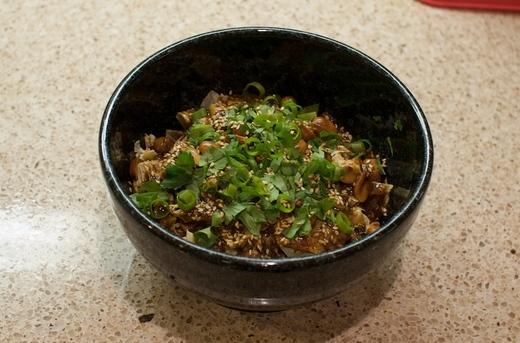



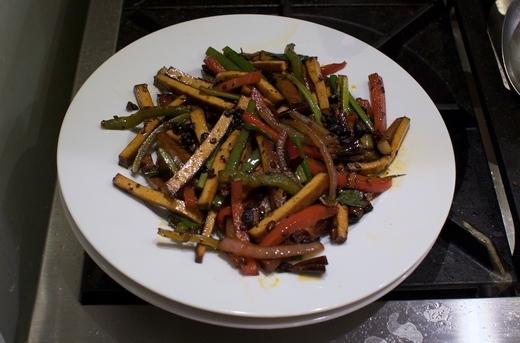
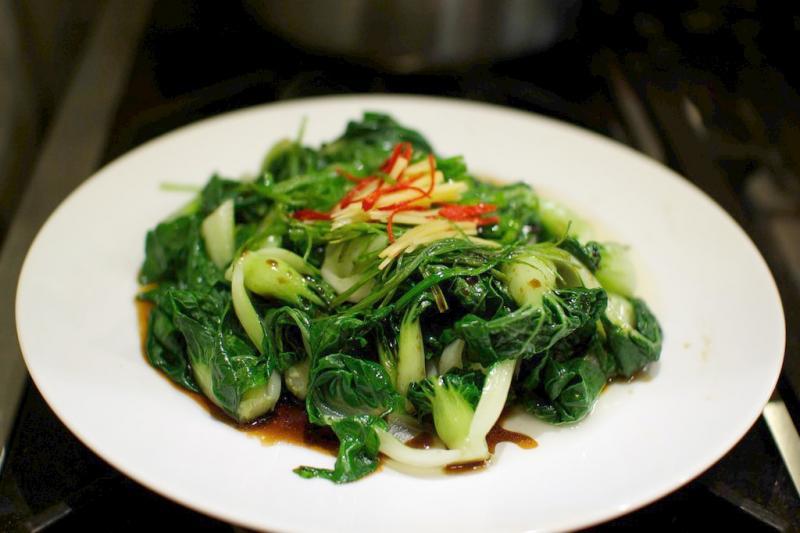
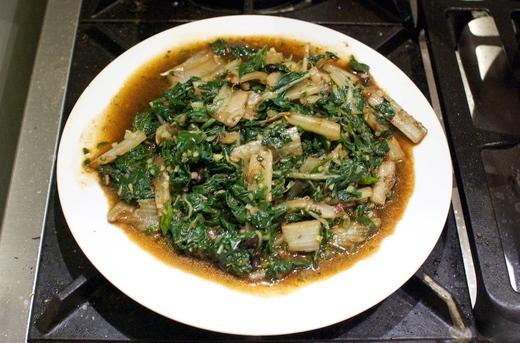
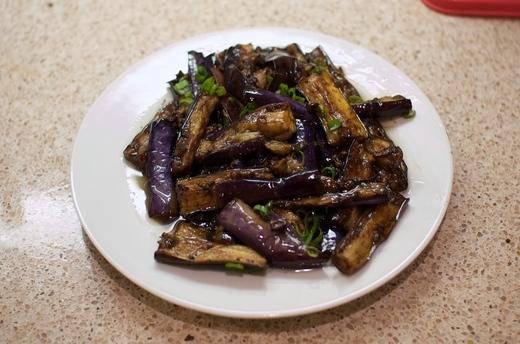
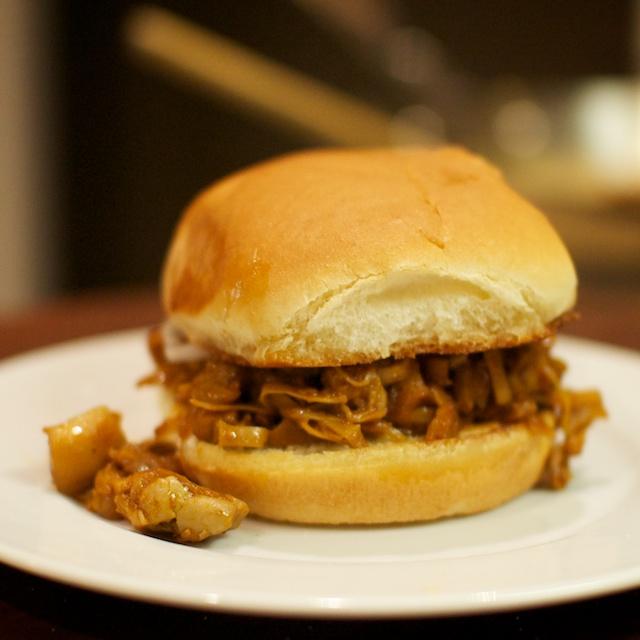

Tea vs coffee...I need your help!
in Coffee & Tea
Posted
Well, for one, they're widely available, not too fussy, and allow viewing of the leaves. But secondly, even with the leaves on top, the device still allows you to separate the leaves and the water (once some water has been poured out). I'm not suggesting it's unique (obviously, other brewing devices can also allow this). I mentioned before that this is not really a preferred method of tea brewing for me, but I think if you're going to use a French press to brew tea (as many shops seem to do, whether because they already have one or because they think it's stylish), this would be the way to do it.